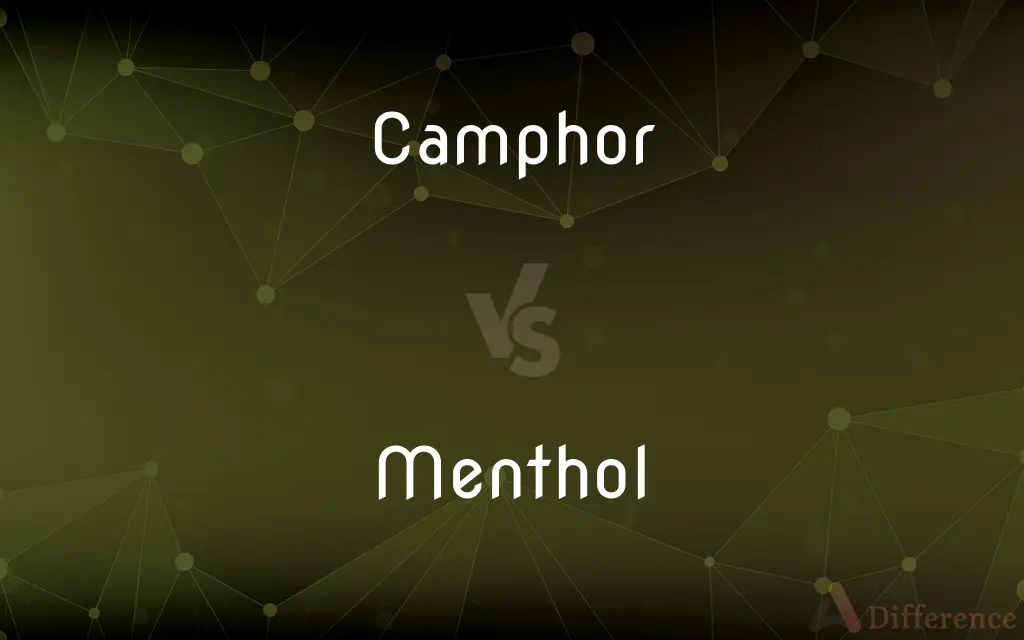Camphor vs. Menthol — What's the Difference?
Edited by Tayyaba Rehman — By Urooj Arif — Updated on March 8, 2024
Camphor is a waxy, flammable substance with a strong aroma, while menthol is a cooling, minty compound.

Difference Between Camphor and Menthol
Table of Contents
ADVERTISEMENT
Key Differences
Camphor and menthol are both organic compounds that are used in medical and cosmetic products due to their distinctive properties. Camphor is derived from the wood of camphor trees and is used for its strong aroma and therapeutic properties, such as relieving pain, itching, and congestion. Menthol, extracted from mint oils or synthesized, is known for its cooling sensation and is used to relieve minor throat irritation and nasal congestion.
While camphor is recognized for its strong, penetrating scent and is used in various applications, including as a moth repellent, in embalming fluids, and in religious ceremonies, menthol is appreciated for its refreshing, minty effect, commonly found in toothpaste, chewing gum, and topical pain relievers. The aroma of camphor is much more potent and can be overwhelming in large quantities, whereas menthol provides a cooling effect without the overpowering scent.
In terms of medical use, camphor is often found in topical analgesics and vapor rubs, where it acts as a counterirritant to reduce pain and swelling. Menthol, on the other hand, is used for its ability to slightly numb the skin's surface, making it effective in soothing sore throats, minor aches, and muscle pains. It is important to note that both camphor and menthol can be toxic if ingested in large quantities and should be used as directed.
Camphor has a broader range of uses outside of medical applications, including in manufacturing plasticizers and as a component of fireworks, due to its flammable nature. Menthol's uses are more focused on its cooling and flavoring properties, making it a favorite in culinary and personal care products.
Despite their different characteristics and uses, both camphor and menthol share the ability to activate TRPM8 receptors in the body, which are responsible for the cooling sensation when applied to the skin or mucous membranes. This action is what makes them popular in products designed to relieve discomfort and provide a sense of freshness.
ADVERTISEMENT
Comparison Chart
Origin
Derived from the wood of camphor trees
Extracted from mint oils or synthesized
Scent
Strong, penetrating aroma
Cooling, minty scent
Uses
Topical analgesics, moth repellents, religious ceremonies
Topical pain relievers, toothpaste, chewing gum
Medical Applications
Relieves pain, itching, and congestion
Soothes sore throats, minor aches, muscle pains
Non-medical Uses
Plasticizers, fireworks
Flavoring in culinary, personal care products
Toxicity
Toxic if ingested in large quantities
Toxic if ingested in large quantities
Effect on TRPM8 Receptors
Activates for cooling sensation
Activates for cooling sensation
Compare with Definitions
Camphor
Known for its strong aroma and flammability.
Camphor blocks are used in traditional ceremonies for their distinct smell.
Menthol
A compound with a cooling, minty effect.
Menthol is often added to toothpaste for a refreshing aftertaste.
Camphor
A waxy substance used in medical and religious contexts.
Camphor is commonly found in ointments to relieve skin irritation.
Menthol
Found in culinary and personal care products.
Menthol is a popular flavoring agent in gum and candy.
Camphor
Can be dangerous if ingested due to its toxicity.
Accidental ingestion of camphor can lead to serious health issues.
Menthol
Provides a cooling sensation without a strong scent.
Topical creams with menthol are used for temporary muscle pain relief.
Camphor
Has therapeutic properties like relieving congestion.
Camphor vapor rub helps clear nasal passages during a cold.
Menthol
Extracted from mint or synthesized in laboratories.
Natural menthol is derived from peppermint oil.
Camphor
Utilized in manufacturing for its chemical properties.
Camphor is a component in certain types of plasticizers.
Menthol
Used to soothe minor throat irritation and aches.
Cough drops with menthol can relieve sore throat symptoms.
Camphor
Camphor () is a waxy, flammable, transparent solid with a strong aroma. It is a terpenoid with the chemical formula C10H16O. It is found in the wood of the camphor laurel (Cinnamomum camphora), a large evergreen tree found in East Asia; and in the related kapur tree (Dryobalanops sp.), a tall timber tree from South East Asia.
Menthol
Menthol is an organic compound made synthetically or obtained from the oils of corn mint, peppermint, or other mints. It is a waxy, crystalline substance, clear or white in color, which is solid at room temperature and melts slightly above.
Camphor
A fragrant white or colorless crystalline ketone, C10H16O, obtained naturally from the wood of the camphor tree or synthesized from pinene and used as an insect repellent, in the manufacture of film, plastics, lacquers, and in medicine chiefly in external preparations to relieve mild pain and itching.
Menthol
A crystalline alcohol with a minty taste and odour, found in peppermint and other natural oils. It is used as a flavouring and in decongestants and analgesics.
Camphor
A resin obtained from the camphor tree; used in making celluloid and liniment
Menthol
A fragrant white crystalline organic compound, C10H20O, obtained from peppermint oil or synthesized. It is used in perfumes, in cigarettes, as a mild topical anesthetic, and as a mint flavoring.
Camphor
(organic compound) A white transparent waxy crystalline isoprenoid ketone, 1,7,7-trimethylbicyclo[2.2.1]heptan-2-one, with a strong pungent odour, used in pharmacy.
Menthol
(chemistry) a cyclic monoterpene alcohol; the major component of the essential oil of peppermint; used in pharmaceutical preparations as an antitussive and antipruritic agent, as a nasal decongestant, and in menthol cigarettes
Camphor
A tough, white, aromatic resin, or gum, obtained from different species of the Laurus family, esp. from Cinnamomum camphara (the Laurus camphora of Linnæus.). Camphor, C10H16O, is volatile and fragrant, and is used in medicine as a diaphoretic, a stimulant, or sedative.
Menthol
A menthol cigarette.
Camphor
Originally, a gum resembling ordinary camphor, obtained from a tree (Dryobalanops aromatica formerly Dryobalanops camphora) growing in Sumatra and Borneo; now applied to its main constituent, a terpene alcohol obtainable as a white solid C10H18O, called also Borneo camphor, Malay camphor, Malayan camphor, camphor of Borneo, Sumatra camphor, bornyl alcohol, camphol, and borneol. The isomer from Dryobalanops is dextrorotatory; the levoratatory form is obtainable from other species of plants, and the racemic mixture may be obtained by reduction of camphor. It is used in perfumery, and for manufacture of its esters. See Borneol.
Menthol
A white, crystalline, aromatic substance (C10H20O) resembling camphor, extracted from oil of peppermint (Mentha); - called also mint camphor or peppermint camphor. It has the peculiar effect on skin and membranes of making them feel cool, and is used in liqueurs, confections, cigarettes, cough drops and perfumes, among other things.
Camphor
To impregnate or wash with camphor; to camphorate.
Menthol
A lotion containing menthol which gives it a mint flavoring
Common Curiosities
What is the main difference between camphor and menthol?
The main difference lies in their scent and origin: camphor has a strong aroma and comes from camphor trees, while menthol offers a cooling, minty scent and is derived from mint oils or synthesized.
How do camphor and menthol affect the body?
They activate TRPM8 receptors, responsible for the cooling sensation, which can help relieve discomfort from pain, itching, or congestion when applied topically.
Why is it dangerous to ingest camphor or menthol?
Both compounds are toxic if ingested in large quantities, potentially leading to serious health issues, including symptoms like nausea, vomiting, or even seizures.
Can camphor and menthol be used in aromatherapy?
Yes, their distinct aromas can be used in aromatherapy; camphor for its penetrating scent and menthol for its refreshing, cooling properties.
Are there any environmental concerns associated with camphor or menthol?
The primary concern is overharvesting of natural sources; sustainable practices and synthetic alternatives can help mitigate environmental impact.
Can both camphor and menthol be used for pain relief?
Yes, both are used in topical analgesics for pain relief, but they work differently: camphor acts as a counterirritant, whereas menthol provides a cooling sensation to soothe pain.
What precautions should be taken when using camphor or menthol?
Use as directed, especially avoiding ingestion and applying only to external areas as excessive use can lead to adverse effects.
Can camphor or menthol cause allergic reactions?
While generally safe, some individuals may experience allergic reactions or sensitivity to camphor or menthol, resulting in skin irritation or other symptoms.
Are camphor and menthol only found in medical products?
No, while they are common in medical applications, they also have various uses in items like moth repellents, fireworks, toothpaste, and flavorings in food and personal care products.
Is natural menthol better than synthesized menthol?
Both forms of menthol have similar effects; the choice between natural and synthesized depends on the product's intended use and manufacturing considerations.
How do camphor and menthol interact with the skin?
They cause a cooling sensation and can slightly numb the skin's surface, which is why they're used to relieve various skin and muscle discomforts.
Can camphor and menthol be used together in products?
Yes, many products, especially topical analgesics and vapor rubs, contain both compounds to utilize their combined therapeutic effects.
What research is being done on camphor and menthol?
Research continues to explore their potential therapeutic effects, safety profiles, and new applications in medicine, cosmetics, and other fields.
How should products containing camphor or menthol be stored?
They should be stored in a cool, dry place, out of reach of children, to prevent accidental ingestion and to maintain their efficacy.
How have the uses of camphor and menthol evolved over time?
Their uses have expanded from traditional medicinal and religious applications to include a wide range of consumer products, leveraging their sensory and therapeutic properties.
Share Your Discovery

Previous Comparison
Arrange vs. Schedule
Next Comparison
Amphiprotic vs. PolyproticAuthor Spotlight
Written by
Urooj ArifUrooj is a skilled content writer at Ask Difference, known for her exceptional ability to simplify complex topics into engaging and informative content. With a passion for research and a flair for clear, concise writing, she consistently delivers articles that resonate with our diverse audience.
Edited by
Tayyaba RehmanTayyaba Rehman is a distinguished writer, currently serving as a primary contributor to askdifference.com. As a researcher in semantics and etymology, Tayyaba's passion for the complexity of languages and their distinctions has found a perfect home on the platform. Tayyaba delves into the intricacies of language, distinguishing between commonly confused words and phrases, thereby providing clarity for readers worldwide.














































